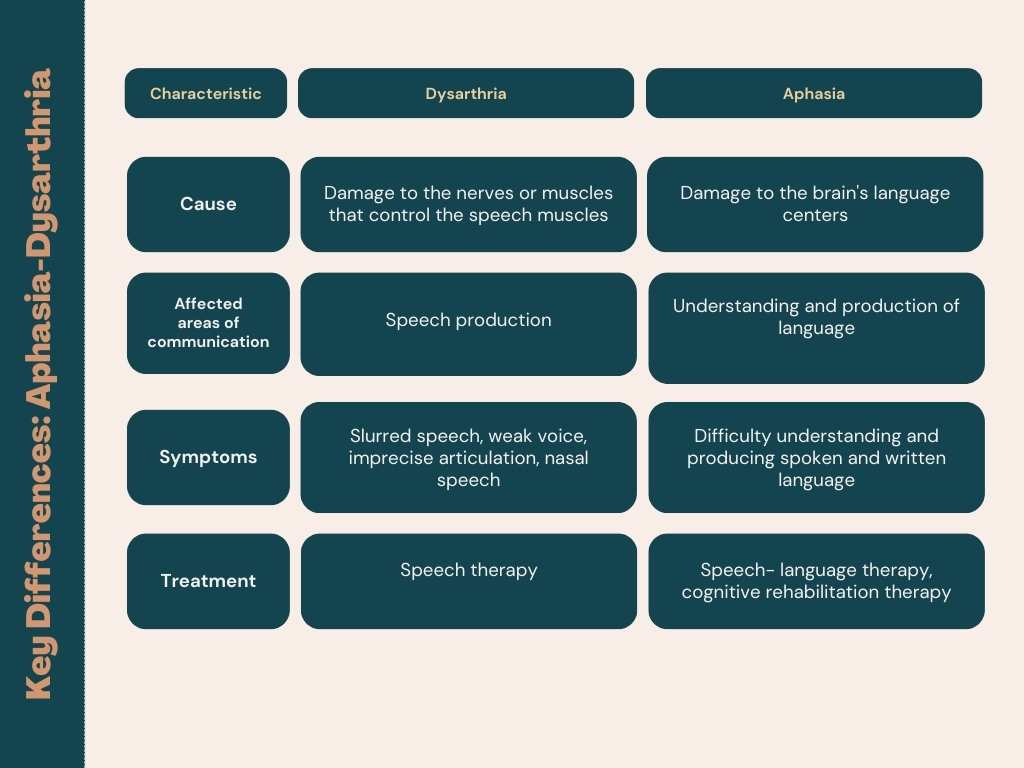Dysarthria vs. Aphasia Disorders: A Complete Guide
Language is a powerful tool for sharing our thoughts, feelings, and ideas. However, when a communication problem interferes with our ability to communicate, it can be difficult and frustrating.
Dysarthria and aphasia are two speech and language disorders that affect how people speak and understand language. These two communication disorders are distinct conditions with different causes, symptoms, and treatment approaches.
This guide will explore dysarthria and aphasia in depth, defining each condition, explaining their differences, exploring their causes, and discussing the therapies that can help people regain their communication abilities.
Key Differences Between Dysarthria and Aphasia
Understanding Dysarthria
What is Dysarthria?
Dysarthria is a speech disorder that affects a person's ability to articulate words and communicate effectively due to muscle weakness or difficulty controlling the muscles used for speech. Dysarthria is a speech disorder that affects the muscles used for speech.
The specific type of dysarthria a person has is contingent on the underlying cause and location of the damage to the nervous system.
Dysarthria can impair the muscles used for speech, including those that control breathing, voice production, articulation, and resonance.
Causes of Dysarthria
Dysarthria can be caused by various underlying conditions or factors, including:
Stroke: A stroke is a sudden interruption of blood flow to the brain that can damage brain cells. When this happens in the areas of the brain that control speech, it can lead to dysarthria.
Brain injury: A brain injury may also cause dysarthria. This can happen from a traumatic brain injury (TBI), such as a fall or a car accident. It can also come from a non-traumatic brain injury, such as a stroke or a tumor.
Neurological disorders: There are many neurological disorders that can cause dysarthria. These include Parkinson's disease, multiple sclerosis, and cerebral palsy. These disorders affect the nervous system, which can lead to weakness, spasticity, or tremors in the muscles used for speech.
Muscular disorders: Muscular disorders can also cause dysarthria. These disorders affect the muscles themselves, making them weak or stiff. This can make it difficult to control the muscles used for speech.
Certain medications: Some medications can cause dysarthria as a side effect. These medications include sedatives, muscle relaxants, and some anticonvulsants.
Congenital conditions: Congenital conditions that can cause dysarthria, including Down syndrome and Pierre-Robin syndrome. These conditions are present at birth and can affect the development of the muscles used for speech.
It is important to note that dysarthria can be caused by a combination of factors. For example, a person who has had a stroke may also have a neurological disorder, such as Parkinson's disease. This can make the dysarthria more severe.
Types of Dysarthria
There are six main types of dysarthria, each of which is caused by damage to a different part of the nervous system:
Spastic dysarthria: This is the most common type of dysarthria. It is caused by damage to the upper motor neurons, which control the muscles used for speech. People with spastic dysarthria have difficulty controlling their muscles, which can lead to slow, stiff, and labored speech.
Flaccid dysarthria: This type of dysarthria is caused by damage to the lower motor neurons, which control the muscles used for speech. People with flaccid dysarthria have weak muscles, which can lead to breathy, weak, and imprecise speech.
Ataxic dysarthria: This type of dysarthria is caused by damage to the cerebellum, which is responsible for coordination. People with ataxic dysarthria have difficulty coordinating their muscles, which can lead to jerky, unsteady, and irregular speech.
Hypokinetic dysarthria: This type of dysarthria is caused by damage to the basal ganglia, which are responsible for movement control. People with hypokinetic dysarthria have slow, monotonous, and reduced speech.
Hyperkinetic dysarthria: This type of dysarthria is caused by damage to the basal ganglia, which are responsible for movement control. People with hyperkinetic dysarthria have involuntary movements of the muscles used for speech, which can lead to jerky, irregular, and spasmodic speech.
Mixed dysarthria: This type of dysarthria is caused by damage to multiple areas of the nervous system. People with mixed dysarthria have a combination of symptoms from the other types of dysarthria.
Hypokinetic Dysarthria
Check out our blog on hypokinetic dysarthria for more information!
Symptoms of Dysarthria
The symptoms of dysarthria can vary depending on the underlying cause and the muscles affected. Some common symptoms include:
Slurred speech: This means that words can be difficult to understand because they sound jumbled or unclear.
Slow speech: Speech may become slower than usual. It may feel like the person is taking their time to form words and sentences.
Monotone speech: The person may have trouble changing the pitch of their voice. This can make their speech sound flat, lacking the usual ups and downs that make language interesting.
Breathing difficulties: The person may have trouble controlling their breath while speaking. This may result in them running out of breath quickly when talking.
Trouble pronouncing words: The person may have difficulty saying sounds correctly and forming words. This can make speech less clear and understandable.
Voice Changes: Spastic dysarthria can lead to changes in the sound of the voice. It might become strained, raspy, or hoarse, making it even more challenging to communicate.
Dysarthria can be caused by various factors, including neurological disorders, traumatic brain injuries, and muscular disorders. The symptoms that a person experiences depend on the underlying cause and the muscles affected.
Dysarthria can be a complex disorder, and each case is unique. It is important to have a thorough evaluation by a speech-language pathologist to determine the specific symptoms and underlying cause of dysarthria. With early intervention, people with dysarthria can learn strategies to improve their speech and communication.
Understanding Aphasia
What is Aphasia?
Aphasia is a complex and multifaceted language disorder that can greatly impact a person's capability to communicate effectively. It can arise from various causes and manifest in different ways, each with its own challenges.
This condition highlights the intricate workings of the brain's language centers and the importance of accurate diagnosis and appropriate treatment. Let's take a closer look at the different aspects of aphasia.
Aphasia is a neurological condition that primarily disrupts a person's ability to understand and produce both spoken and written language. This disruption is typically caused by damage to specific areas of the brain, most commonly in the left hemisphere.
In contrast to dysarthria, aphasia does not affect the control of the muscles used in speech production. This means that a person with aphasia may still be able to speak, but the meaning of the words may be difficult to understand.
The specific symptoms of aphasia can vary depending on the type and severity of the disorder. Some common symptoms include:
Difficulty understanding spoken language
Difficulty producing spoken language
Difficulty reading
Difficulty writing
Difficulty naming objects
Difficulty following instructions
Aphasia can be a challenging condition to live with, but there are treatments available that can help people improve their communication skills.
Causes of Aphasia
Aphasia is caused by damage to the brain's areas that control language. This damage can be caused by a variety of factors, including:
Stroke: Stroke is the most common cause of aphasia. A stroke occurs when a blood vessel in the brain ruptures or becomes blocked, which cuts off the flow of blood to the brain. This can damage the brain cells in the language areas.
Head injury: A head injury can also cause aphasia.
Brain tumor: A brain tumor can also cause aphasia. This is because the tumor can press on or damage the brain's language areas.
Dementia: Dementia is a group of brain disorders that cause a decline in thinking, memory, and other cognitive abilities. Some types of dementia, such as Alzheimer's disease, can also cause aphasia.
Progressive Aphasia: Progressive aphasia is a rare type of aphasia that gets worse over time. It is caused by a neurodegenerative disorder, such as primary progressive aphasia.
A person's specific type of aphasia will depend on the damaged area of the brain. For example, if the damage is to the Broca's area, the person may have an expressive, non-fluent aphasia. The person may have fluent or receptive aphasia if the damage is to the Wernicke's area.
It is important to note that aphasia is not always permanent. In some cases, the damage to the brain can heal, and the person's language skills can improve. However, the damage is permanent in other cases, and the person will have aphasia for the rest of their life.
Types of Aphasia
Broca's aphasia (Expressive Aphasia): Broca's aphasia is caused by damage to the Broca's area, which is located in the brain's frontal lobe. This area is responsible for the production of speech. People with Broca's aphasia have difficulty speaking, and their speech is often slow, halting, and grammatically incorrect. They may also have difficulty understanding spoken language.
Wernicke's aphasia (Fluent Aphasia): Wernicke's aphasia is caused by damage to the Wernicke's area, which is located in the brain's temporal lobe. This area is responsible for the comprehension of speech. People with Wernicke's aphasia have difficulty understanding spoken language and may make up words or use words incorrectly. Their speech may also be fluent, but it is often meaningless.
Global aphasia: Global aphasia is the most severe type of aphasia. It is caused by damage to Broca's and Wernicke's areas. People with global aphasia have difficulty understanding and producing speech. They may also have difficulty reading and writing.
Anomic aphasia: Anomic aphasia is caused by damage to the brain's area responsible for storing words. People with anomic aphasia have difficulty naming objects but can still understand and produce speech.
Transcortical aphasia: Transcortical aphasia is caused by damage to the pathways that connect the brain's language areas. People with transcortical aphasia have difficulty understanding or producing speech but can still repeat words and phrases.
Mixed aphasia: Mixed aphasia is a combination of two or more types of aphasia.
A person's type of aphasia can depend on the damaged area of the brain, the handedness of the individual, and the severity of the damage.
The prognosis for people with aphasia varies depending on the type and severity of the disorder. People with mild aphasia may make significant improvements with treatment. However, people with severe aphasia may have more limited improvement.
Anomic Aphasia
Check out our blog on anomic aphasia for more information!
Symptoms of Aphasia
The symptoms of aphasia vary depending on the type and severity of the disorder. However, some common symptoms include:
Difficulty understanding spoken language: People with aphasia may have trouble understanding what others are saying. They may ask for clarification frequently or misunderstand what is being said.
Difficulty producing spoken language: People with aphasia may have trouble speaking. Their speech may be slow, halting, and grammatically incorrect. They may also have difficulty finding the right words, or they may make up words.
Difficulty reading: People with aphasia may have difficulty reading. They may have difficulty understanding what they are reading, or they may have difficulty decoding words.
Difficulty writing: People with aphasia may have trouble writing. They may have difficulty spelling words, or they may have difficulty forming sentences.
Difficulty naming objects: People with aphasia may have difficulty naming objects. They may know what an object is, but they may not be able to say its name.
Difficulty following instructions: People with aphasia may have trouble following instructions. They may misunderstand what is being said or have difficulty remembering the instructions.
Key Differences Between Dysarthria and Aphasia
Dysarthria and aphasia are two different speech disorders that can affect a person's ability to communicate. However, they have different causes and affect different aspects of communication.
Dysarthria is a speech disorder that affects the muscles used for speech. It is caused by damage to the nerves or muscles that control the speech muscles. Dysarthria can affect the strength, coordination, and control of the muscles used for speech, which can lead to problems with articulation, voice quality, and respiratory support for speech.
Aphasia is a language disorder that affects a person's ability to understand and produce language. It is caused by damage to the brain's language centers. Aphasia can affect a person's ability to understand spoken and written language, as well as their ability to produce spoken and written language.
Here is a table summarizing the key differences between dysarthria and aphasia:
Diagnosis and Treatment
Diagnosis
The diagnosis of aphasia and dysarthria is typically made by a speech-language pathologist (SLP). The SLP will thoroughly evaluate the person's speech and language skills. This may include:
A medical history and physical examination
A speech assessment
A language assessment
The SLP will use the evaluation results to determine the disorder's type and severity.
Treatment
The treatment for aphasia and dysarthria typically involves speech therapy. Speech therapy can help people with aphasia and dysarthria improve their communication skills.
For people with aphasia, speech therapy may focus on:
Improving the person's ability to understand spoken language
Improving the person's ability to produce spoken language
Teaching the person alternative communication strategies, such as using gestures or writing
For people with dysarthria, speech therapy may focus on:
Improving the person's muscle strength and coordination
Improving the person's breath support for speech
Teaching the person strategies to improve their speech clarity
In addition to speech therapy, people with aphasia and dysarthria may also benefit from other treatments, such as:
Cognitive rehabilitation therapy: This type of therapy can help people with aphasia improve their memory, attention, and problem-solving skills.
Occupational therapy: This type of therapy can help people with dysarthria improve their fine motor skills and coordination.
Family counseling: This type of counseling can help families learn how to support their loved ones with aphasia or dysarthria.
The prognosis for people with aphasia and dysarthria varies depending on the type and severity of the disorder. However, with early intervention and treatment, many people with aphasia and dysarthria can make significant improvements in their communication skills.
Similarities in treatment
Both aphasia and dysarthria can be treated with speech therapy. Speech therapy can help people with both disorders improve their communication skills.
Differences in treatment
The main difference in the treatment of aphasia and dysarthria is the focus of the therapy. Speech therapy for aphasia focuses on improving the person's ability to understand and produce language. Speech therapy for dysarthria focuses on improving the person's muscle strength and coordination for speech.
Other differences in treatment may include:
The frequency of therapy sessions
The length of therapy sessions
The specific techniques used in therapy
Frequently Asked Questions About Dysarthria vs. Aphasia
1. Can dysarthria and aphasia occur simultaneously?
Yes, dysarthria and aphasia can occur simultaneously. In fact, they often do. This is because the conditions can be caused by the same underlying factors, such as stroke, brain injury, and neurological disorders.
2. Are dysarthria and aphasia reversible?
The reversibility of dysarthria and aphasia depends on the disorder's cause and the damage's severity.
Dysarthria is often reversible if the underlying cause can be treated. For example, if dysarthria is caused by a stroke, the person's speech may improve as they recover from the stroke. However, if dysarthria is caused by a progressive neurological disorder, such as Parkinson's disease, the person's speech may continue to deteriorate over time.
Aphasia is often not reversible, but people can learn to compensate for their language difficulties with speech therapy. The amount of improvement that a person with aphasia makes will depend on the severity of the damage and the person's motivation and ability to participate in therapy.
In both cases, early intervention is important for maximizing the chances of improvement. Speech therapy can help people with dysarthria and aphasia develop strategies to improve their communication skills.
3. Can children develop dysarthria or aphasia?
Children can develop dysarthria or aphasia, although these conditions are more commonly associated with adults. Dysarthria may be present in children due to conditions like cerebral palsy or developmental disorders affecting speech-motor control.
Aphasia in children can result from brain injuries, strokes, or other neurological conditions. Early diagnosis and intervention by pediatric SLPs are crucial for improving communication abilities in children with these conditions.
4. How can family members and caregivers support individuals with dysarthria or aphasia?
Family members and caregivers play a crucial role in supporting individuals with dysarthria or aphasia. Here are some ways to provide support:
Be patient and understanding. It may take time for people with dysarthria or aphasia to communicate effectively. Be patient and understanding, and don't get frustrated if they don't understand what you are saying or if they have difficulty speaking.
Use simple language and avoid jargon. When speaking to people with dysarthria or aphasia, use simple language and avoid jargon. Speak slowly and clearly, and enunciate your words.
Be direct and to the point. Be direct and to the point when communicating with people with dysarthria or aphasia. Avoid beating around the bush or using indirect language.
Use gestures and facial expressions. Gestures and facial expressions can help people with dysarthria or aphasia understand what you are saying. When you are speaking to them, use gestures and facial expressions to reinforce your message.
Repeat yourself as needed. If people with dysarthria or aphasia don't understand what you are saying, don't be afraid to repeat yourself. Repeating yourself can help them to understand your message.
Provide written information. If people with dysarthria or aphasia have difficulty understanding what you are saying, provide them with written information. This can help them to understand your message more easily.
How Can Connected Speech Pathology Help You
Connected Speech Pathology is dedicated to providing a comprehensive and compassionate approach to addressing communication disorders. We understand that every individual is unique, and we tailor our services to meet the specific needs of each person we serve. Whether you are dealing with dysarthria, aphasia, or any other speech or language challenge, our highly skilled and passionate speech-language pathologists (SLPs) support you on your journey toward improved communication and an enhanced quality of life.
Our commitment to specialized and personalized care begins with a thorough assessment of your condition. We take the time to understand your individual communication difficulties and goals. This assessment helps us develop a customized treatment plan that targets your specific needs and maximizes your progress.
We understand that the path to enhanced communication skills and an improved quality of life may involve various strategies and techniques. Our therapy sessions incorporate many exercises, including articulation drills, language therapy, cognitive-communication strategies, and assistive communication devices when necessary. We also strongly emphasize involving family members and caregivers in the therapeutic process, ensuring that you have a supportive network to reinforce your progress beyond our sessions.
Connected Speech Pathology is not just a provider of services; we are partners in your journey toward better communication. Our commitment to excellence, personalized care, and continuous improvement ensures that you receive the highest quality speech-language therapy. We can unlock your full communication potential and improve your overall well-being.
Conclusion
Aphasia and dysarthria are two distinct communication disorders that affect speech and language in different ways. Dysarthria is a motor speech disorder that affects the muscles used for speech, while aphasia is a language disorder that affects the ability to understand and use language.
A speech-language pathologist (SLP) can diagnose both aphasia and dysarthria. The SLP will conduct a comprehensive evaluation to determine the type and severity of the disorder.
Treatment for aphasia and dysarthria typically involves speech therapy. Speech therapy can help people with these disorders improve their communication skills. The specific goals of speech therapy will vary depending on the individual's needs.
It is important to remember that people with aphasia and dysarthria can make significant progress with the right treatment and support. With the help of skilled professionals and the dedication of both individuals and their families, many can regain their ability to communicate effectively and improve their overall quality of life.
About the Author
Allison Geller is a communication coach, speech-language pathologist, and founder of Connected Speech Pathology, an international online practice providing professional communication coaching and speech therapy for children, teens, and adults. With more than two decades of experience, she has worked in medical and educational settings, published research on aphasia, and leads a team of specialists helping clients improve skills in public speaking, vocal presence, accent clarity, articulation, language, fluency, and interpersonal communication.










